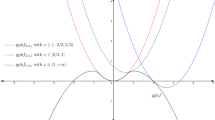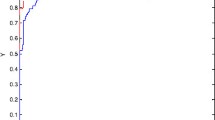Abstract
The negative gradient direction to find local minimizers has been associated with the classical steepest descent method which behaves poorly except for very well conditioned problems. We stress out that the poor behavior of the steepest descent methods is due to the optimal Cauchy choice of steplength and not to the choice of the search direction. We discuss over and under relaxation of the optimal steplength. In fact, we study and extend recent nonmonotone choices of steplength that significantly enhance the behavior of the method. For a new particular case (Cauchy-Barzilai-Borwein method), we present a convergence analysis and encouraging numerical results to illustrate the advantages of using nonmonotone overrelaxations of the gradient method.
Similar content being viewed by others
References
H. Akaike, “On a successive transformation of probability distribution and its application to the analysis of the optimum gradient method,” Ann. Inst. Statist. Math. Tokyo, vol. 11, pp. 1–16, 1959.
J. Barzilai and J.M. Borwein, “Two point step size gradient methods,” IMA J. Numer. Anal., vol. 8, pp. 141–148, 1988.
C. Brezinski, Padé—Type Approximation and General Orthogonal Polynomials, Birkhauser—Verlag: Basel, 1980.
A. Cauchy, “Méthodes générales pour la résolution des systèmes d'équations simultanées,” C. R. Acad. Sci. Par., vol. 25, pp. 536–538, 1847.
Y.H. Dai and L.Z. Liao, “R-linear convergence of the Barzilai and Borwein gradient method,” Technical Report AMSS 1999-081, Academy of Mathematics and Systems Sciences, Beijing, China, 1999.
A. Friedlander, J.M. Martinez, B. Molina, and M. Raydan, “Gradient method with retards and generalizations,” SIAM J. Numer. Anal., vol. 36, pp. 275–289, 1999.
W. Glunt, T.L. Hayden, and M. Raydan, “Molecular conformations from distance matrices,” J. Comp. Chem., vol. 14, pp. 114–120, 1993.
D. Luenberger, Linear and Nonlinear Programming, Addison-Wesley: Menlo Park, CA, 1984.
M. Raydan, “On the Barzilai and Borwein choice of steplength for the gradient method,” IMA J. Numer. Anal., vol. 13, pp. 321–326, 1993.
Author information
Authors and Affiliations
Rights and permissions
About this article
Cite this article
Raydan, M., Svaiter, B.F. Relaxed Steepest Descent and Cauchy-Barzilai-Borwein Method. Computational Optimization and Applications 21, 155–167 (2002). https://doi.org/10.1023/A:1013708715892
Issue Date:
DOI: https://doi.org/10.1023/A:1013708715892




